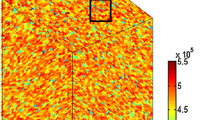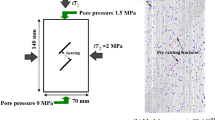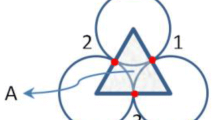Abstract
Understanding the mechanisms of crack propagation and failure behavior in rocks is fundamental for geotechnical engineering and mining applications. This study employs a coupled damage model based on the Smoothed Particle Hydrodynamics (SPH) method that integrates the Drucker–Prager and Grady–Kipp models. This mixed failure model is then implemented to simulate the crack propagation morphology and failure modes in uniaxial compression tests of flawed rock samples, and validated against multiple experimental observations. The numerical results exhibit good agreement with experimental observations from the literature in terms of the initiation and propagation of tensile and shear fractures, as well as the final failure morphology. Additionally, this work incorporates contact algorithms to simulate the loading plates, thereby better representing the actual experimental conditions encountered in uniaxial compression tests. Furthermore, a comprehensive parametric study is conducted to investigate the influence of key factors, such as pre-flaw geometry, cohesion, friction at the loading plate interface, and discretization parameters, on the simulated fracture processes and mechanical response. The outcomes indicate the proposed coupled damage model within the SPH framework can accurately capture complex fracture patterns and failure mechanisms in uniaxial compression of flawed rocks. This work demonstrates the capability of the SPH-based mixed-mode failure model to provide insights into rock fracture and failure mechanisms.
Highlights
-
A coupled damage model integrating the Drucker–Prager and Grady–Kipp criteria within a smoothed particle hydrodynamics (SPH) framework is applied to simulate both shear and tensile failure modes in rocks firstly. The model is validated against more experimental observations, demonstrating the model's ability to reproduce the crack propagation and characteristic stress–strain behavior.
-
This work presents a comprehensive parametric study investigating the influence of key factors, such as pre-flaw geometry, cohesion, friction at the loading plate interface, and discretization parameters, on the simulated fracture processes and mechanical response. These systematic investigations provide valuable insights into the governing mechanisms and highlight the importance of proper model calibration for accurate predictions.
-
This work incorporates contact algorithms to simulate the loading plates, thereby better representing the actual experimental conditions encountered in uniaxial compression tests. The tensile wing cracks subjected to uniaxial compression, oriented vertically towards the top boundary of the specimen, are successfully captured.
















Similar content being viewed by others
Data Availability
The related data used to support the findings of this study are included within the article.
References
Ambati M, Gerasimov T, De Lorenzis L (2015) A review on phase-field models of brittle fracture and a new fast hybrid formulation. Comput Mech 55(2):383–405. https://doi.org/10.1007/s00466-014-1109-y
An HM et al (2017) Hybrid finite-discrete element modelling of dynamic fracture and resultant fragment casting and muck-piling by rock blast. Comput Geotech 81:322–345. https://doi.org/10.1016/j.compgeo.2016.09.007
Bleyer J, Alessi R (2018) Phase-field modeling of anisotropic brittle fracture including several damage mechanisms. Comput Method Appl M 336:213–236. https://doi.org/10.1016/j.cma.2018.03.012
Bonilla-Sierra V et al (2015) Rock slope stability analysis using photogrammetric data and DFN-DEM modelling. Acta Geotech 10(4):497–511. https://doi.org/10.1007/s11440-015-0374-z
Bui HH, Fukagawa R (2013) An improved SPH method for saturated soils and its application to investigate the mechanisms of embankment failure: case of hydrostatic pore-water pressure. Int J Numer Anal Methods Geomech 37(1):31–50
Bui HH, Sako K, Fukagawa R (2007) Numerical simulation of soil-water interaction using smoothed particle hydrodynamics (SPH) method. J Terramech 44(5):339–346
Bui HH, Fukagawa R, Sako K, Ohno S (2008) Lagrangian meshfree particles method (SPH) for large deformation and failure flows of geomaterial using elastic-plastic soil constitutive model. Int J Numer Anal Methods Geomech 32(12):1537–1570
Chen YF, Lin H, Wang YX, **e SJ, Zhao YL, Yong WX (2021) Statistical damage constitutive model based on the Hoek–Brown criterion. Archiv Civ Mech Eng 21(3):117. https://doi.org/10.1007/s43452-021-00270-y
Cheng SF, Ye Y, Zeng YW, Gao R, Qin XR (2023) Numerical investigation on the debonding of cement anchorage in clay rocks based on a hybrid FEM/DEM model. Comput Geotech 156:105276. https://doi.org/10.1016/j.compgeo.2023.105276
Das R, Cleary PW (2010) Effect of rock shapes on brittle fracture using smoothed particle hydrodynamics. Theor Appl Fract Mech 53(1):47–60. https://doi.org/10.1016/j.tafmec.2009.12.004
De Chant LJ (2005) Validation of a computational implementation of the Grady-Kipp dynamic fragmentation theory for thin metal plate impacts using an analytical strain-rate model and hydrodynamic analogues. Mech Mater 37(1):83–94. https://doi.org/10.1016/j.mechmat.2003.12.008
Deng Y, Yin F, Deng HC, Li J, Liu W (2020) Research on crack propagation and rock fragmentation efficiency under spherical tooth dynamic indentation. Arab J Geosci 13(1):1–9. https://doi.org/10.1007/s12517-019-4926-7
Dong XW, Liu GR, Li ZL, Zeng W (2016) A smoothed particle hydrodynamics (SPH) model for simulating surface erosion by impacts of foreign particles. Tribol Int 95:267–278. https://doi.org/10.1016/j.triboint.2015.11.038
Douillet-Grellier T, Jones B, Pramanik R, Pan K, Albaiz A, Williams J (2016) Mixed-mode fracture modeling with smoothed particle hydrodynamics. Comput Geotech 79:73–85. https://doi.org/10.1016/j.compgeo.2016.06.002
Drucker DC, Prager W (1952) Soil mechanics and plastic analysis or limit design. Quart Appl Math 10(2):157–165. https://doi.org/10.1090/qam/48291
Drucker DC, Prager W, Greenberg HJ (1952) Extended limit design theorems for continuous media. Quart Appl Math 9(4):381–389. https://doi.org/10.1090/qam/45573
Eftekhari M, Baghbanan A, Hashemolhosseini H (2016) Crack propagation in rock specimen under compressive loading using extended finite element method. Arab J Geosci 9(2):145. https://doi.org/10.1007/s12517-015-2196-6
Fan H, Huang D, Wang G (2021a) A four-way enhanced numerical manifold method for crack propagation and failure analysis of rock slopes. Appl Math Model 95:623–643. https://doi.org/10.1016/j.apm.2021.02.025
Fan H, Huang D, Wang G (2021b) Cone-complementary manifold method for stability and failure analysis of jointed/fractured rock masses. Comput Geotech 131:103955. https://doi.org/10.1016/j.compgeo.2020.103955
Fu JW et al (2017) Simulating progressive failure in brittle jointed rock masses using a modified elastic-brittle model and the application. Eng Fract Mech 178:212–230. https://doi.org/10.1016/j.engfracmech.2017.04.037
Giannakeas IN et al (2020) Coupling XFEM and peridynamics for brittle fracture simulation: part II—adaptive relocation strategy. Comput Mech 66(3):683–705. https://doi.org/10.1007/s00466-020-01872-8
Grady DE, Kipp ME (1980) Continuum modelling of explosive fracture in oil shale. Int J Rock Mech Min 17(3):147–157. https://doi.org/10.1016/0148-9062(80)91361-3
Gray JP, Monaghan JJ (2004) Numerical modelling of stress fields and fracture around magma chambers. J Volcanol Geotherm Res 135(3):259–283. https://doi.org/10.1016/j.jvolgeores.2004.03.005
Gray JP, Monaghan JJ, Swift RP (2001) SPH elastic dynamics. Comput Meth Appl Mech Eng 190(49–50):6641–6662. https://doi.org/10.1016/S0045-7825(01)00254-7
Hu M, Gao T, Dong XW, Tan QT, Yi C, Wu F, Bao AH (2023) Simulation of soil-tool interaction using smoothed particle hydrodynamics (SPH). Soil till Res 229:105671. https://doi.org/10.1016/j.still.2023.105671
Huang Y, Bao YJ, Zhang M, Liu C, Lu P (2015) Analysis of the mechanism of seabed liquefaction induced by waves and related seabed protection. Nat Hazards 79(2):1399–1408. https://doi.org/10.1007/s11069-015-1897-1
Jiang MJ, Jiang T, Crosta GB, Shi ZM, Chen H, Zhang N (2015) Modeling failure of jointed rock slope with two main joint sets using a novel DEM bond contact model. Eng Geol 193:79–96. https://doi.org/10.1016/j.enggeo.2015.04.013
Jiang H, Liu Z, Gao K (2017) Numerical simulation on rock fragmentation by discontinuous water-jet using coupled SPH/FEA method. Powder Technol 312:248–259. https://doi.org/10.1016/j.powtec.2017.02.047
Kaus BJP (2010) Factors that control the angle of shear bands in geodynamic numerical models of brittle deformation. Tectonophysics 484(1–4):36–47. https://doi.org/10.1016/j.tecto.2009.08.042
Keller A, Hutter K (2014) A viscoelastic damage model for polycrystalline ice, inspired by Weibull-distributed fiber bundle models. Part I: Constitutive models. Continuum Mech Therm 26(6):879–894. https://doi.org/10.1007/s00161-014-0348-7
Lajtai EZ (1971) A theoretical and experimental evaluation of the Griffith theory of brittle fracture. Tectonophysics 11(2):129–156. https://doi.org/10.1016/0040-1951(71)90060-6
Li PF (2015) Study on model test of the process of the rocklike materials failure based on acoustic emission and image processing technology. Chongqing University, Chongqing
Li Z, Ji C, Li Y, Xu LR (2007) The brittle fracture criterion based on the maximum tensile stress on the surface of blunt crack tip. Mech Res Commun 34(5–6):472–479. https://doi.org/10.1016/j.mechrescom.2007.03.004
Liu XS et al (2016) Damage constitutive model based on energy dissipation for intact rock subjected to cyclic loading. Int J Rock Mech Min 85:27–32. https://doi.org/10.1016/j.ijrmms.2016.03.003
Liu Y, Liu W, Wang C (2023) Mechanical properties and constitutive model of fractured red sandstone under acid corrosion. SN Appl Sci 5(7):1–13. https://doi.org/10.1007/s42452-023-05415-7
Melosh H, Ryan E, Asphaug E (1992) Dynamic fragmentation in impacts—hydrocode simulation of laboratory impacts. J Geophys Res-Planet 97(E9):14735–14759. https://doi.org/10.1029/92JE01632
Monaghan J (1992) Smoothed particle hydrodynamics. Annu Rev Astron Astr 30:543–574. https://doi.org/10.1146/annurev.aa.30.090192.002551
Monaghan JJ (2000) SPH without a tensile instability. J Comput Phys 159(2):290–311. https://doi.org/10.1006/jcph.2000.6439
Mu DR, Wen AH, Zhu DQ, Tang AP, Nie Z, Wang ZY (2022) An improved smoothed particle hydrodynamics method for simulating crack propagation and coalescence in brittle fracture of rock materials. Theor Appl Fract Mec 119:103355. https://doi.org/10.1016/j.tafmec.2022.103355
Niu Y, Liu GJ, Zhong Z, Wang JG, Zhang RR, Liu BL (2023) Numerical investigation on fracture characteristic and failure mechanism of rock-like materials with intermittent flaws under compressive-shear loading. Constr Build Mater 388:131698. https://doi.org/10.1016/j.conbuildmat.2023.131698
Rabczuk T, Ren H (2017) A peridynamics formulation for quasi-static fracture and contact in rock. Eng Geol 225:42–48. https://doi.org/10.1016/j.enggeo.2017.05.001
Sharafisafa M, Nazem M (2014) Application of the distinct element method and the extended finite element method in modelling cracks and coalescence in brittle materials. Comput Mater Sci 91:102–121. https://doi.org/10.1016/j.commatsci.2014.04.006
Singh A, Seshagiri Rao K, Ayothiraman R (2019) A closed-form analytical solution for circular opening in rocks using Drucker–Prager criterion. Indian Geotech J 49(4):437–454. https://doi.org/10.1007/s40098-019-00358-6
Sun X, Sakai M, Yamada Y (2013) Three-dimensional simulation of a solid–liquid flow by the DEM–SPH method. J Comput Phys 248:147–176. https://doi.org/10.1016/j.jcp.2013.04.019
Wang CL, He BB, Hou XL, Li JY, Liu L (2020) Stress-energy mechanism for rock failure evolution based on damage mechanics in hard rock. Rock Mech Rock Eng 53(3):1021–1037. https://doi.org/10.1007/s00603-019-01953-y
Wang ZL (2018) Study on mechanical properties and failure law of single fractured rock-like material under uniaxial compression. Yangtze University. Available at: https://kns.cnki.net/kcms2/article/abstract?v=3uoqIhG8C475KOm_zrgu4lQARvep2SAkZIGkvqfmUZglMdu7fCR484ebBRzodA8D5lUJsv0NvHwQ2dSL1V321_Sj_Kihyrfu&uniplatform=NZKPT
Yang JP, Chen WZ, Yang DS, Yuan JQ (2015) Numerical determination of strength and deformability of fractured rock mass by FEM modeling. Comput Geotech 64:20–31. https://doi.org/10.1016/j.compgeo.2014.10.011
Yang SQ, Tian WL, Ranjith PG, Liu XR, Chen M, Cai W (2022) Three-dimensional failure behavior and cracking mechanism of rectangular solid sandstone containing a single fissure under triaxial compression. Rock Mech Bull 1(1):100008. https://doi.org/10.1016/j.rockmb.2022.100008
Zhai SF, Zhou XP, Bi J, **ao N (2016) The effects of joints on rock fragmentation by TBM cutters using general particle dynamics. Tunn Undergr Sp Tech 57:162–172. https://doi.org/10.1016/j.tust.2016.01.035
Zhang T, Zhou XP (2023) Ordinary state-based peridynamic plastic model with Drucker–Prager criterion considering geometric nonlinearity. Appl Math Model 118:212–235. https://doi.org/10.1016/j.apm.2023.01.007
Zheng L, Wu YH, Wu W, Zhang H, Peng XY, Zhang XL, Wu XZ (2021) Efficient investigation of rock crack propagation and fracture behaviors during impact fragmentation in rockfalls using parallel DDA. Adv Civ Eng. https://doi.org/10.1155/2021/5901561
Zhou X, Chen J (2019) Extended finite element simulation of step-path brittle failure in rock slopes with non-persistent en-echelon joints. Eng Geol 250:65–88. https://doi.org/10.1016/j.enggeo.2019.01.012
Zhou C et al (2020) A new damage model accounting the effect of joint orientation for the jointed rock mass. Arab J Geosci 13(7):295. https://doi.org/10.1007/s12517-020-5274-3
Acknowledgements
The authors want to thank the support of the Sichuan Province key research and development project ( No.2023YFS0438 ), Technology Support Program Project of Guizhou Province (Grant No. [2021] General 341) and Innovation Research 2035 Pilot Plan of Southwest University(SWU-XDPY22003).
Funding
The authors are grateful to Sichuan Province key research and development project via a project: No. 2023YFS0438, Technology Support Program Project of Guizhou Province via a project: Grant No. [2021] General 341, Innovation Research 2035 Pilot Plan of Southwest University via a project: SWU-XDPY22003.
Author information
Authors and Affiliations
Contributions
All authors contributed to the study conception and design. Supervision, Project administration, Funding acquisition and Formal analysis were performed by Man Hu. The first draft of the manuscript was written by Qiuting Tan and all authors commented on previous versions of the manuscript. Coding and Data curation were performed by Qiuting Tan. Software and Resources were performed by Dianlei Feng and Yi Ren. Supervision was performed by Yu Huang. All authors read and approved the final manuscript.
Corresponding authors
Ethics declarations
Conflict of interest
The authors declare that they have no known competing financial interestsor personal relationships that could have appeared to influence the work reported in this paper.
Additional information
Publisher's Note
Springer Nature remains neutral with regard to jurisdictional claims in published maps and institutional affiliations.
Rights and permissions
Springer Nature or its licensor (e.g. a society or other partner) holds exclusive rights to this article under a publishing agreement with the author(s) or other rightsholder(s); author self-archiving of the accepted manuscript version of this article is solely governed by the terms of such publishing agreement and applicable law.
About this article
Cite this article
Hu, M., Tan, Q., Feng, D. et al. Simulation of Rock Crack Propagation and Failure Behavior Based on a Mixed Failure Model with SPH. Rock Mech Rock Eng (2024). https://doi.org/10.1007/s00603-024-04001-6
Received:
Accepted:
Published:
DOI: https://doi.org/10.1007/s00603-024-04001-6




